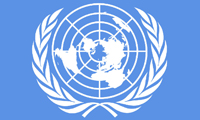 Creator of the United Nations Logo, Oliver Lincoln Lundquist, Dead at 92
Creator of the United Nations Logo, Oliver Lincoln Lundquist, Dead at 92Flag of the United Nations.
NEW YORK, NY.- Oliver Lincoln Lundquist (September 20, 1916 — December 28, 2008) was an American designer and architect, best known for leading the team which designed the prototype emblem which became the United Nations' logo, and for designing the well-known blue and white Q-Tip box.
Lundquist was born in Westbury, New York, the son of an architect. He grew up in Peekskill, New York and studied architecture at Columbia University. As a senior there in 1937, he was hired to work in the office of well-known architect Raymond Loewy, receiving training from Loewy himself. At the Loewy firm, he worked on the Chrysler pavilion for the 1939 New York World's Fair, devising a wind tunnel which would show the air flows around Chrysler's latest car. He also devised a "frozen forest" which would dramatize Chrysler's latest automotive feature, the air conditioning system. Made up of trees with refrigerant inside, the forest became a popular retreat on hot summer days at the Fair site.
Lundquist was commissioned as a lieutenant in the United States Navy, which utilized his graphic design talents. Lundquist served in the Office of Strategic Services, where he worked with Alger Hiss and fellow architect Eero Saarinen. Lundquist would prepare visual presentations for the Joint Chiefs of Staff, as well as for the Washington press corps.
In 1943, Lundquist won top honors in Art & Architecture's Post War Living housing competition, for a house which he designed with Saarinen.
After being discharged from the Navy, Lundquist led the team responsible for graphic design for the United Nations Conference in San Francisco in April 1945. The initial design for the badge, initially created by Donald McLaughlin, who worked for Lundquist, was only intended to decorate the delegates' badges, not as a logo for any organization. The design, as developed by the team, was blue because the color was seen as the opposite of red, the color of war. It was more centered on the United States as host nation of the conference than is today's United Nations logo, and it excluded southern South America, since Argentina was not expected to join the United Nations (it did so later). The UN kept the idea of an azimuthal north polar projection of the world within olive branches, but rotated the design somewhat, and expanded it so that all major continents could be seen in full.
Lundquist returned to private practice in architecture and design. He designed a number of private residences, as well as hospitals, schools, and New York City Parks Department buildings. He was a pioneer in the use of track lighting. While still working for Loewy, he designed the distinctive blue and white Q-Tip box.
 Creator of the United Nations Logo, Oliver Lincoln Lundquist, Dead at 92
Creator of the United Nations Logo, Oliver Lincoln Lundquist, Dead at 92